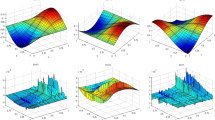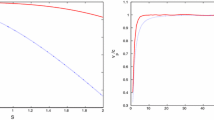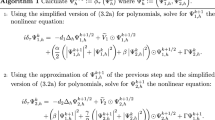Abstract
In this paper, two new energy-conserved splitting methods (EC-S-FDTDI and EC-S-FDTDII) for Maxwell’s equations in two dimensions are proposed. Both algorithms are energy-conserved, unconditionally stable and can be computed efficiently. The convergence results are analyzed based on the energy method, which show that the EC-S-FDTDI scheme is of first order in time and of second order in space, and the EC-S-FDTDII scheme is of second order both in time and space. We also obtain two identities of the discrete divergence of electric fields for these two schemes. For the EC-S-FDTDII scheme, we prove that the discrete divergence is of first order to approximate the exact divergence condition. Numerical dispersion analysis shows that these two schemes are non-dissipative. Numerical experiments confirm well the theoretical analysis results.
Similar content being viewed by others
References
Brekhovskikh L.M. (1980). Waves in Layered Media. Academic, New York
Dai W. and Raja N. (1995). A new ADI scheme for solving three-dimensional parabolic equations with first-order derivatives and variable coefficients. J. Comput. Anal. Appl. 122: 223–250
Crandall C.G. and Majda A. (1980). The method of fractional steps for conservation laws. Numer. Math. 34: 285–314
Kim S. and Douglas J. Jr (2001). Improved accuracy for locally one-dimensional methods for parabolic equations. Math. Models Methods Appl. Sci. 11: 1563–1579
Rachford H.H. and Douglas J. Jr (1956). On the numerical solution of heat conduction problems in two and three space wariables. Trans. Am. Math. Soc. 82: 421–439
Eyges L. (1972). The Classical Electromagnetic Fields. Addison-Wesley, Reading
Feng K. and Qin M. (2003). Symplectic Geometric Algorithms for Hamiltonian Systems (in chinese). Zhejiang Science & Technology Press, Hangzhou
Fortin M. and Brezzi F. (1991). Mixed and Hybrid Finite Elements Methods. Springer, New York
Gao L., Zhang B. and Liang D. (2007). The splitting-difference time-domain methods for Maxwell’s equations in two dimensions. J. Comput. Appl. Math. 205: 207–230
Gedney S.D., Liu G., Roden J.A. and Zhu A. (2001). Perfectly matched layer media with CFS for an unconditional stable ADI-FDTD method. IEEE Trans. Antennas Propagation 49: 1554–1559
Hairer, E., Lubich, C., Wanner, G.: Geometric numerical integration: Structure-preserving algorithms for ordinary differential equations. Springer Series in Computational Mathematic, vol 31. Springer, Heidelberg (2002)
Holland R. (1984). Implicit three-dimensional finite differencing of Maxwell’s equations. IEEE Trans. Nucl. Sci. 31: 1322–1326
Ihlenburg, F.: Finite element analysis of acoustic scattering. Applied mmathematical Sciences, vol 132. Springer, Heidelberg (1998)
Karlsen K.H. and Lie K.-A. (1999). An unconditionally stable splitting scheme for a class of nonlinear parabolic equations. IMA J. Numer. Anal. 19: 1–28
Leis R. (1986). Initial Boundary Value Problems in Mathematical Physics. Wiley, New York
Liang D., Du C. and Wang H. (2007). A fractional step ELLAM approach to high-dimensional convection-diffusion problems with forward particle tracking. J. Comput. Phys. 221: 198–225
Morton, K.W., Mayers, D.F.: Numerical Solution of Partial Differential Equations, 2nd edn. Cambridge University Press, (2005)
Monk P. (2003). Finite Element Methods for Maxwell’s Equations. Clarendon press, Oxford
Namiki T. (1999). A new FDTD algorithm based on alternating direction implicit method. IEEE Trans. Microwave Theory Tech. 47: 2003–2007
Peaceman D.W. and Rachford H.H. (1955). The numerical soltuion of parabolic and elliptic differentce equations. J. Soc. Ind. Appl. Math. 3: 28–41
Strang G. (1968). On the construction and comparison of difference scheme. SIAM J. Numer. Anal. 5: 506–517
Taflove A. and Brodwin M.E. (1975). Numerical solution of steady-state electromagnetic scattering problems using the time-dependent Maxwell’s equations. IEEE Trans. Microwave Theory Tech. 23: 623–630
Yanenko, N.N.: The Method of Fractional Steps: The Soltuions of Problems of Mathematical Physics in Several Variables, English translation edited by M.Holt. Springer, Heidelberg (1971)
Zhao A.P. (2002). Analysis of the numerical dispersion of the 2-D alternating-direction implicit FDTD method. IEEE Trans. Microwave Theory Tech. 50: 1156–1164
Zhang F. and Chen Z. (2000). Numerical dispersion analysis of the unconditionally stable ADI-FDTD method. IEEE Trans. Microwave Theory Tech. 49: 1006–1009
Zheng F., Chen Z. and Zhang J. (2000). Toward the development of a three-dimensional unconditionally stable finite-difference-time-domain method. IEEE Trans. Microwave Theory Tech. 48: 1550–1558
Author information
Authors and Affiliations
Corresponding author
Rights and permissions
About this article
Cite this article
Chen, W., Li, X. & Liang, D. Energy-conserved splitting FDTD methods for Maxwell’s equations. Numer. Math. 108, 445–485 (2008). https://doi.org/10.1007/s00211-007-0123-9
Received:
Revised:
Published:
Issue Date:
DOI: https://doi.org/10.1007/s00211-007-0123-9




